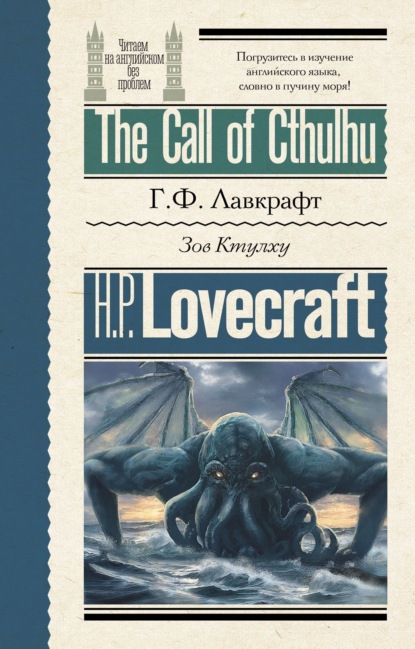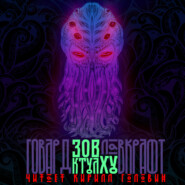По всем вопросам обращайтесь на: info@litportal.ru
(©) 2003-2024.
✖
The Call of Cthulhu / Зов Ктулху
Настройки чтения
Размер шрифта
Высота строк
Поля
Meanwhile no more can be told. There was a secret which could not be extracted. Mankind was not absolutely alone among the conscious things of earth: some shapes came out of the dark to visit the faithful few[62 - to visit the faithful few – чтобы посетить немногих верных]. But these were not the Great Old Ones. No man had ever seen the Old Ones. The carven idol was great Cthulhu, but nobody might say how the others looked like. No one could read the old writing now, but things were told by word of mouth. The chanted ritual was not the secret – that was never spoken aloud, only whispered. The chant meant only this: “In his house at R’lyeh dead Cthulhu waits dreaming.”
Only two of the prisoners were found sane enough to be hanged, and the rest were taken to various hospitals. All denied ritual murders, and said that the killing had been done by Black Winged Ones[63 - Black Winged Ones – Чернокрылые] which had come to them from their immemorial meeting-place in the haunted wood. And nothing more could be known. What the police learned came mainly from the immensely aged mestizo named Castro[64 - immensely aged mestizo named Castro – весьма престарелый метис по имени Кастро], who said that he had sailed to different ports and talked with undying leaders of the cult in the mountains of China.
Old Castro remembered bits of hideous legend that made man and the world seem recent and transient indeed. There had been ages when other Creatures ruled on the earth, and They had had great cities. Remains of Them, the deathless Chinamen had told him, could still be found as Cyclopean stones on islands in the Pacific[65 - on islands in the Pacific – на островах Тихого океана]. They all died long ago before men came, but there were ways which could revive Them when the stars had come round again to the right positions in the cycle of eternity. They had, indeed, come themselves from the stars, and brought Their images with Them.
These Great Old Ones, Castro continued, were not composed altogether of flesh and blood. They had shape but that shape was not made of matter. When the stars came round to the right positions, They could travel from world to world through the sky; but when the stars were wrong, They could not live. But although They no longer lived, They would never really die. They all lay in stone houses in Their great city of R’lyeh, preserved by the spells of mighty Cthulhu for a glorious resurrection when the stars and the earth might once more be ready for Them. But at that time some force from outside must serve to liberate Their bodies. The spells prevented Them from making an initial move, and They could only lie awake in the dark and think while millions of years passed by. They knew all that was occurring in the universe, for Their mode of speech was transmitted thought. Even now They talked in Their tombs. When, after infinities of chaos, the first men came, the Great Old Ones spoke to the sensitive among them by moulding their dreams; for only thus could Their language reach the fleshly minds.
Then, whispered Castro, those first men formed the cult around tall idols which the Great Ones showed them; idols brought in dim eras from dark stars. That cult would never die till the stars came right again, and the secret priests would take great Cthulhu from His tomb to revive His servants and resume His rule of earth. This time would be easy to know, for then mankind would become as the Great Old Ones; free and wild and beyond good and evil, with laws and morals thrown aside. And all men would be shouting and killing and revelling in joy. Then the liberated Old Ones would teach them new ways to shout and kill and revel and enjoy themselves, and all the earth would flame with a holocaust of ecstasy and freedom. Meanwhile the cult, by appropriate rites, must keep alive the memory of those ancient ways and tell about their return.
In the elder time chosen men had talked with the entombed Old Ones in dreams, but then something happened. The great stone city R’lyeh, with its monoliths and sepulchres, had sunk beneath the waves; and the deep waters, full of the one primal mystery through which not even thought can pass, had cut off the communication. But memory never died, and the high-priests said that the city would rise again when the stars were right. Then the black spirits of earth would come out, mouldy and shadowy, and full of dim rumours. But old Castro dared not speak much of them. He became silent hurriedly, and said nothing more. He curiously declined to mention the size of the Old Ones, too. Of the cult, he said that he thought the centre lay amid the pathless desert of Arabia, where Irem, the City of Pillars[66 - Irem, the City of Pillars – Ирем, град колонн], dreams hidden and untouched. It was not connected to the European witch-cult, and was virtually unknown beyond its members. No book had ever mentioned it, though the deathless Chinamen said that there were double meanings in the Necronomiconof the mad arab Abdul Alhazred[67 - Necronomicon of the mad arab Abdul Alhazred – «Некромикон» безумного араба Абдулы Альхазреда] which the initiated might read, especially the this couplet:
“That is not dead which can eternal lie[68 - That is not dead which can eternal lie. – Не мёртво то, что может вечно покоиться.],
And with strange ages even death may die.”
Legrasse, deeply impressed, had inquired about the historic affiliations of the cult. Castro, apparently, had told the truth when he said that it was wholly secret. The authorities at Tulane University[69 - Tulane University – Тулейнский университет (частный исследовательский университет, расположенный в городе Новый Орлеан, Луизиана, США)] could say nothing about either cult or image, and now the detective had come to the highest authorities in the country and met with the Greenland tale of Professor Webb.
The great interest aroused at the meeting by Legrasse’s tale is echoed in the correspondence of those who attended; although it was not mentioned in the formal publications of the society. Caution is the first care of scientists who often face charlatanry and imposture. Legrasse lent the image to Professor Webb. When Professor had died, it was returned to him. I viewed it not long ago. It is truly a terrible thing, and akin to the dream-sculpture of young Wilcox.
I did not wonder that my uncle was excited by the tale of the sculptor. Professor Angell started an investigation immediately; though privately I suspected young Wilcox of trickery. He could invent a series of dreams to heighten and continue the mystery. So, after thoroughly studying the manuscript again and correlating the theosophical and anthropological notes with the cult narrative of Legrasse, I made a trip to Providence to see the sculptor and accuse him of imposing upon a learned and aged man.
Wilcox still lived alone in the Fleur-de-Lys Building in Thomas Street, a hideous Victorian imitation of 17th century Breton Architecture[70 - Victorian imitation of 17th century Breton Architecture – викторианская имитация бретонской архитектуры XVII века]. I found him at work in his rooms, and understood at once that his genius is indeed profound and authentic. I believe one day he will be well-known as one of the great decadents; for he has crystallised in clay and in marble those nightmares and phantasies which Arthur Machen[71 - Arthur Machen – Артур Мейчен (1863–1947), английский (валлийский) писатель, автор фантасмагорических историй.] evokes in prose, and Clark Ashton Smith[72 - Clark Ashton Smith – Кларк Эштон Смит (1983–1961), американский поэт и писатель, художник, скульптор; писал рассказы в жанре фантастики, фэнтэзи и ужасов.] makes visible in verse and in painting.
Dark, frail, he asked me about my business without rising. Then I told him who I was, he displayed some interest; for my uncle had excited his curiosity studying his strange dreams, yet had never explained the reason for the study. In a short time I became convinced of his absolute sincerity, for he spoke of the dreams in a manner none could mistake. They had influenced his art profoundly, and he showed me a morbid statue whose contours almost made me shake. He could not recall the original of this thing except in his own dream bas-relief, but the outlines had formed themselves insensibly under his hands. It was, no doubt, the giant shape he had seen in delirium. But he really knew nothing of the hidden cult.
He talked of his dreams in a strangely poetic fashion; making me see the damp Cyclopean city of slimy green stone – whose geometry, he said, was all wrong – and hear with frightened expectancy the ceaseless, half-mental calling from underground: “Cthulhu fhtagn”, “Cthulhu fhtagn.”
These words had formed part of that dread ritual which told of dead Cthulhu’s dream-vigil in his stone vault at R’lyeh, and I felt deeply touched despite my rational beliefs. Wilcox, I was sure, had heard of the cult in some casual way, and had soon forgotten it amidst the mass of his equally weird reading and imagining. Later it had found subconscious expression in dreams, in the bas-relief, and in the terrible statue. The young man was slightly affected and slightly ill-mannered, that type I never liked, but I admit both his genius and his honesty. I wish him all the success his talent promises.
The matter of the cult still fascinated me, and sometimes I met serious researches. I visited New Orleans, talked with Legrasse and other people of that old-time party, saw the frightful image, and even questioned some mongrel prisoners. Old Castro, unfortunately, had been dead for some years. What I now heard was really no more than a detailed confirmation of what my uncle had written, and it excited me. I felt sure that I touched a very real, very secret, and very ancient religion whose discovery would make me a famous scientist. My attitude was absolute materialistic.
One thing I began to suspect, and which I now fear I know, is that my uncle’s death was not natural. He fell on a narrow hill street leading up from an ancient waterfront, after a careless push from a negro sailor. I did not forget the mixed blood and marine background of the cult-members in Louisiana, and I would not be surprised to learn of secret methods and rites and beliefs. Legrasse and his men, it is true, have been alive; but in Norway a certain seaman who saw everything is dead. Maybe the deeper inquiries of my uncle have come to sinister ears? I think Professor Angell died because he knew too much, or because he could learn too much. And at the moment I have learned much, too.
III. The Madness
from the Sea
I had almost ceased my inquiries into what Professor Angell called the “Cthulhu Cult”, and was visiting a learned friend in Paterson, New Jersey; the curator of a local museum and a famous mineralogist. Examining one day the stones in a rear room of the museum, my eye noticed an odd picture in one of the old papers spread beneath the stones. It was the Australian journal, theSydney Bulletin[73 - Australian journal, the Sydney Bulletin – австралийский журнал «Сиднейский бюллетень»], for April 18, 1925. There was a picture of a hideous stone image almost identical with that which Legrasse had found in the swamp.
I read the article in detail. It was of great significance to my quest; and I carefully tore it out. It read as follows:
MYSTERY DERELICT FOUND AT SEA
Vigilant Arrives With Helpless Armed New Zealand Yacht in Tow[74 - Vigilant Arrives With Helpless Armed New Zealand Yacht in Tow. – «Неусыпный» прибывает в порт с неуправляемой новозеландской яхтой на буксире.].
One Survivor and Dead Man Found Aboard. Tale of Desperate Battle and Deaths at Sea. Rescued Seaman Refuses Particulars of Strange Experience. Odd Idol Found in His Possession. Inquiry to Follow[75 - Inquiry to Follow. – Предстоит расследование.].
The Morrison Co.’s freighter Vigilant[76 - the Morrison Co.’s freighter Vigilant – сухогруз «Неусыпный», принадлежащий компании «Моррисон»], bound from Valparaiso[77 - Valparaiso – Вальпараисо, город и морской порт в Чили], arrived this morning at its wharf in Darling Harbour[78 - Darling Harbour – Дарлинг-Харбор], having in tow the battled and disabled but heavily armed steam yachtAlertof Dunedin, N.Z[79 - steam yacht Alert of Dunedin, N.Z. – паровая яхта «Бдительная» из Данедина, Новая Зеландия]., which was sighted April 12th in S. Latitude[80 - S. Latitude – южная широта] 34°21’, W. Longitude[81 - W. Longitude – западная долгота] 152°17’, with one living and one dead man aboard.
The Vigilant left Valparaiso March 25th, and on April 2nd was driven considerably south of its course by exceptionally heavy storms and monster waves. On April 12th the derelict was sighted. One survivor in a half-delirious condition and one man who had evidently been dead for more than a week were found. The living man was holding a horrible stone idol of unknown origin, about foot in height. Its nature is unknown, the authorities at Sydney University, the Royal Society, and the Museum in College Street say. The survivor says he found it in the cabin of the yacht, in a small carved shrine.
This man told an exceedingly strange story of piracy and slaughter. He is Gustaf Johansen[82 - Gustaf Johansen – Густав Йохансен], a Norwegian, from the two-masted schoonerEmmaof Auckland[83 - two-masted schooner Emma of Auckland – двухмачтовая шхуна «Эмма» из Окленда], which sailed for Callao[84 - Callao – Кальяо, автономный регион в Перу на побережье Тихого океана] February 20th with a complement of eleven men. The Emma, he says, was delayed and thrown widely south of her course by the great storm of March 1st, and on March 22nd, in S. Latitude 49°51’ W. Longitude 128°34’, encountered the Alert, manned by a queer and evil-looking crew of Kanakas and half-castes[85 - Kanakas and half-castes – канаки и полукровки]. They ordered to turn back, Capt. Collins[86 - Capt. Collins – капитан Коллинз] refused; and the strange crew began to fire savagely and without warning. Though the schooner began to sink from shots beneath the water-line, the Emma’s men managed to heave alongside their enemy and board it. They were forced to kill them all.
Three of the Emma’s men, including Capt. Collins and First Mate Green[87 - First Mate Green – первый помощник Грин], were killed; and the remaining eight under Second Mate Johansen[88 - under Second Mate Johansen – под командованием второго помощника Йохансена] proceeded to navigate the captured yacht. The next day, it appears, they raised and landed on a small island, although none knew about it in that part of the ocean. Six of the men somehow died ashore; Johansen says very little about this part of his story. Later, it seems, he and one companion boarded the yacht and tried to manage it, but were driven by the storm of April 2nd. From that time till his rescue on the 12th the man remembers little, and he does not even recall when William Briden[89 - William Briden – Уильям Брайден], his companion, died. There was no apparent cause for Briden’s death, and it happened probably due to excitement or exposure. The Alert was well known as an island trader[90 - island trader – каботажное судно], and bore an evil reputation. It was owned by a curious group of half-castes whose frequent meetings and night trips to the woods attracted curiosity. It started in great haste just after the storm and earth tremors of March 1st. Our Auckland correspondent gives the Emma and her crew an excellent reputation, and Johansen is described as a sober and worthy man. The admiralty will make Johansen speak more freely than he has done hitherto.
This was all, together with the picture of the hellish image; but what a train of ideas it started in my mind! Here were new data on the Cthulhu Cult, and evidence that it had strange interests at sea as well as on land. Why did the hybrid crew order the Emma to sail back? What was the unknown island on which six of the Emma’s crew had died, and about which Johansen was so secretive? And most important, what deep connection of dates was there, so carefully noted by my uncle?
March 1st – or February 28th according to the International Date Line[91 - according to the International Date Line – согласно международной демаркацией суточного времени] – the earthquake and storm had come. The Alert and her crew had sailed eagerly from Dunedin as if somebody had summoned it, and on the other side of the earth poets and artists had begun to dream of a strange Cyclopean city while a young sculptor had moulded in his sleep the form of the dreaded Cthulhu. March 23rd the crew of the Emma landed on an unknown island and left six men dead; and on that date the dreams of sensitive men gained heightened vividness and darkened with dread of a giant monster’s malign pursuit, while an architect had gone mad and a sculptor had gone suddenly into delirium! And what of this storm of April 2nd – the date on which all dreams of the strange city ceased, and Wilcox recovered from the strange fever? An old Castro talked about the sunken, star-born Old Ones and their coming reign; their faithful cult and their mastery of dreams. In some way the second of April had stopped monstrous menace, the siege of mankind’s soul.
That evening I took a train for San Francisco. In less than a month I was in Dunedin; where, however, I found that little was known of the strange cult-members who had entered the old sea-taverns. But there was vague talk about one inland trip these mongrels had made, during which faint drumming and red flame were noted on the distant hills. In Auckland I learned that Johansen had returned with yellow hair turned white[92 - yellow hair turned white – русые волосы поседели] after a questioning at Sydney, and had thereafter sold his cottage in West Street and sailed with his wife to his old home in Oslo. All the admiralty officials could do was to give me his Oslo address.
After that I went to Sydney and talked uselessly with seamen and members of the vice-admiralty court. I saw the Alert, now sold and in commercial use, but gained nothing. The crouching image with its cuttlefish head, dragon body, scaly wings, and hieroglyphed pedestal, was preserved in the Museum at Hyde Park; and I studied it long and well. Geologists, the curator told me, had found it a monstrous puzzle; for they vowed that the rock like it did not exist. Then I remembered the words Old Castro had told Legrasse about the Old Ones: “They had come from the stars, and had brought Their images with Them.”
I decided to visit Mate Johansen in Oslo. Johansen lived, I discovered, in the Old Town. I made a brief taxi-trip, and knocked at the door of a neat and ancient building. A sad-faced woman in black came out and told me that Gustaf Johansen was dead.
He had not lived long after his return, said his wife, the sea events in 1925 had broken him. He had told her no more than he told the public, but had left a long manuscript – of “technical matters” as he said – written in English. During a walk near the Gothenburg dock, a bundle of papers falling from an attic window had knocked him down. Two sailors at once helped him, but before the ambulance could reach him he was dead. Physicians said that his death occurred due to a heart trouble and a weakened constitution.
I persuaded the widow that I had to get her husband’s “technical matters”. I bore the document away and began to read it on the London boat.
It was a naive sailor’s effort at a diary – to recall day by day that last awful voyage.
Johansen, thank God, did not know quite all, even though he saw the city and the Thing. I shall never sleep calmly again when I think of the horrors that lurk ceaselessly behind life in time and in space, and of those blasphemies from elder stars which dream beneath the sea.
Johansen’s voyage had begun just as he told it to the vice-admiralty. The Emma had left Auckland on February 20th, and had felt the full force of the earthquake-born tempest. Once more under control[93 - once more under control – снова подчиняясь управлению], the ship was making good progress when held up[94 - when held up – когда бы остановлен] by the Alert on March 22nd, and I could feel the mate’s regret as he wrote of her bombardment and sinking. He speaks with significant horror of the swarthy cult-fiends on the Alert. Then, driven ahead by curiosity in their captured yacht under Johansen’s command, the men saw a great stone pillar sticking out of the sea, and in S. Latitude 47°9’, W. Longitude l23°43’, came upon a coastline of mingled mud, ooze, and weedy Cyclopean masonry which can be nothing less than the tangible substance of earth’s supreme terror – the nightmare corpse-city of R’lyeh, that was built in measureless ages behind history by the vast, loathsome creatures that came down from the dark stars. There lay great Cthulhu and his hordes, hidden in green slimy vaults and sending out the thoughts that spread fear to the dreams of the sensitive. The thoughts called imperiously to the faithful to come on a pilgrimage of liberation and restoration. All this Johansen did not suspect, but he soon saw enough!
I suppose that only a single mountain-top, the hideous monolith-crowned citadel whereon great Cthulhu was buried, actually emerged from the waters. Johansen and his men were awed by the cosmic majesty of this dripping Babylon of elder demons, and probably guessed that it was nothing of this planet. Awe at the unbelievable size of the greenish stone blocks, at the height of the great carven monolith, and at the identity of the colossal statues and bas-reliefs with the queer image found in the shrine on the Alert, is visible in every line of the frightened description.
Johansen and his men landed at a sloping mud-bank on this monstrous Acropolis, and clambered slipperily up over titan oozy blocks. Even the sun seemed distorted.
It was Rodriguez the Portuguese[95 - Rodriguez the Portuguese – португалец Родригес] who climbed up the foot of the monolith and shouted of what he had found. The rest followed him, and looked curiously at the immense carved door with the squid-dragon bas-relief. It was, Johansen said, like a great barn-door; and they all felt that it was a door, though they could not decide whether it lay flat like a trap-door[96 - trap-door – дверь-люк] or slantwise like an outside cellar-door. As Wilcox said, the geometry of the place was all wrong. One could not be sure that the sea and the ground were horizontal, because the relative position of everything else seemed phantasmally variable.
Briden pushed at the stone in several places without result. Then Donovan[97 - Donovan – Донован] studied the edge, pressing each point separately. He climbed along the grotesque stone moulding – and the men wondered how any door in the universe could be so vast. Then, very softly and slowly, the acre-great lintel began to go down; and they saw that it was balanced.
Everyone watched the queer recession of the monstrously carven portal. In this prismatic distortion it moved in a diagonal way.
The aperture was black. The odour rising from the newly opened depths was intolerable. Everyone listened, and everyone was listening still when It appeared and gropingly squeezed Its gelatinous green immensity through the black doorway into the tainted outside air of that poison city of madness.
Of the six men who never reached the ship, two died immediately. The Thing cannot be described – there is no language for such abysms of shrieking and immemorial lunacy, such contradictions of all matter, force, and cosmic order. A mountain walked or stumbled. God! Whatwonder[98 - what wonder – что же удивляться] that across the earth a great architect went mad, and poor Wilcox raved with fever in that telepathic instant? The Thing of the idols, the green, sticky spawn of the stars, had awaked to claim his own[99 - to claim his own – заявить свои права]. The stars were right again, and what an age-old cult had failed to do, a band of innocent sailors had done by accident. After millions of years great Cthulhu was loose again, and ravening for delight.
Three men were swept up by the flabby claws before anybody turned. God rest them, if there be any rest in the universe. They were Donovan, Guerrera, and Angstrom[100 - Donovan, Guerrera, and Angstrom – Донован, Геррера и Ангстром]. Parker slipped as the other three were running to the boat, and Johansen swears he was swallowed up by masonry. When Briden and Johansen reached the boat, and pulled desperately for the Alert, the mountainous monstrosity flopped down the slimy stones and was floundering at the edge of the water.
Slowly, amidst the distorted horrors of that indescribable scene, the Alert began to sail; while on the masonry of that shore great Cthulhu slid greasily into the water and began to pursue. Briden looked back and went mad. He kept on laughing till death found him one night in the cabin while Johansen was wandering deliriously.
But Johansen had not surrendered. Knowing that the Thing could surely overtake the Alert, he set the engine for full speed, and reversed the wheel. The brave Norwegian drove his vessel head on against the pursuing jelly. Johansen drove on relentlessly.
There was a horrific bursting as of an exploding bladder, a stench as of a thousand opened graves, and a sound that the chronicler could not put on paper. For an instant the ship was hidden by an acrid green cloud, and – God in heaven! [101 - God in heaven! – Великий Боже!] – the distance widened every second as the Alert gained impetus from its mounting steam.
That was all. After that Johansen only watched the idol in the cabin and prepared some food for himself and the laughing maniac. He did not try to navigate, for he was completely exhausted. Then came the storm of April 2nd, and he lost his consciousness.
Only two of the prisoners were found sane enough to be hanged, and the rest were taken to various hospitals. All denied ritual murders, and said that the killing had been done by Black Winged Ones[63 - Black Winged Ones – Чернокрылые] which had come to them from their immemorial meeting-place in the haunted wood. And nothing more could be known. What the police learned came mainly from the immensely aged mestizo named Castro[64 - immensely aged mestizo named Castro – весьма престарелый метис по имени Кастро], who said that he had sailed to different ports and talked with undying leaders of the cult in the mountains of China.
Old Castro remembered bits of hideous legend that made man and the world seem recent and transient indeed. There had been ages when other Creatures ruled on the earth, and They had had great cities. Remains of Them, the deathless Chinamen had told him, could still be found as Cyclopean stones on islands in the Pacific[65 - on islands in the Pacific – на островах Тихого океана]. They all died long ago before men came, but there were ways which could revive Them when the stars had come round again to the right positions in the cycle of eternity. They had, indeed, come themselves from the stars, and brought Their images with Them.
These Great Old Ones, Castro continued, were not composed altogether of flesh and blood. They had shape but that shape was not made of matter. When the stars came round to the right positions, They could travel from world to world through the sky; but when the stars were wrong, They could not live. But although They no longer lived, They would never really die. They all lay in stone houses in Their great city of R’lyeh, preserved by the spells of mighty Cthulhu for a glorious resurrection when the stars and the earth might once more be ready for Them. But at that time some force from outside must serve to liberate Their bodies. The spells prevented Them from making an initial move, and They could only lie awake in the dark and think while millions of years passed by. They knew all that was occurring in the universe, for Their mode of speech was transmitted thought. Even now They talked in Their tombs. When, after infinities of chaos, the first men came, the Great Old Ones spoke to the sensitive among them by moulding their dreams; for only thus could Their language reach the fleshly minds.
Then, whispered Castro, those first men formed the cult around tall idols which the Great Ones showed them; idols brought in dim eras from dark stars. That cult would never die till the stars came right again, and the secret priests would take great Cthulhu from His tomb to revive His servants and resume His rule of earth. This time would be easy to know, for then mankind would become as the Great Old Ones; free and wild and beyond good and evil, with laws and morals thrown aside. And all men would be shouting and killing and revelling in joy. Then the liberated Old Ones would teach them new ways to shout and kill and revel and enjoy themselves, and all the earth would flame with a holocaust of ecstasy and freedom. Meanwhile the cult, by appropriate rites, must keep alive the memory of those ancient ways and tell about their return.
In the elder time chosen men had talked with the entombed Old Ones in dreams, but then something happened. The great stone city R’lyeh, with its monoliths and sepulchres, had sunk beneath the waves; and the deep waters, full of the one primal mystery through which not even thought can pass, had cut off the communication. But memory never died, and the high-priests said that the city would rise again when the stars were right. Then the black spirits of earth would come out, mouldy and shadowy, and full of dim rumours. But old Castro dared not speak much of them. He became silent hurriedly, and said nothing more. He curiously declined to mention the size of the Old Ones, too. Of the cult, he said that he thought the centre lay amid the pathless desert of Arabia, where Irem, the City of Pillars[66 - Irem, the City of Pillars – Ирем, град колонн], dreams hidden and untouched. It was not connected to the European witch-cult, and was virtually unknown beyond its members. No book had ever mentioned it, though the deathless Chinamen said that there were double meanings in the Necronomiconof the mad arab Abdul Alhazred[67 - Necronomicon of the mad arab Abdul Alhazred – «Некромикон» безумного араба Абдулы Альхазреда] which the initiated might read, especially the this couplet:
“That is not dead which can eternal lie[68 - That is not dead which can eternal lie. – Не мёртво то, что может вечно покоиться.],
And with strange ages even death may die.”
Legrasse, deeply impressed, had inquired about the historic affiliations of the cult. Castro, apparently, had told the truth when he said that it was wholly secret. The authorities at Tulane University[69 - Tulane University – Тулейнский университет (частный исследовательский университет, расположенный в городе Новый Орлеан, Луизиана, США)] could say nothing about either cult or image, and now the detective had come to the highest authorities in the country and met with the Greenland tale of Professor Webb.
The great interest aroused at the meeting by Legrasse’s tale is echoed in the correspondence of those who attended; although it was not mentioned in the formal publications of the society. Caution is the first care of scientists who often face charlatanry and imposture. Legrasse lent the image to Professor Webb. When Professor had died, it was returned to him. I viewed it not long ago. It is truly a terrible thing, and akin to the dream-sculpture of young Wilcox.
I did not wonder that my uncle was excited by the tale of the sculptor. Professor Angell started an investigation immediately; though privately I suspected young Wilcox of trickery. He could invent a series of dreams to heighten and continue the mystery. So, after thoroughly studying the manuscript again and correlating the theosophical and anthropological notes with the cult narrative of Legrasse, I made a trip to Providence to see the sculptor and accuse him of imposing upon a learned and aged man.
Wilcox still lived alone in the Fleur-de-Lys Building in Thomas Street, a hideous Victorian imitation of 17th century Breton Architecture[70 - Victorian imitation of 17th century Breton Architecture – викторианская имитация бретонской архитектуры XVII века]. I found him at work in his rooms, and understood at once that his genius is indeed profound and authentic. I believe one day he will be well-known as one of the great decadents; for he has crystallised in clay and in marble those nightmares and phantasies which Arthur Machen[71 - Arthur Machen – Артур Мейчен (1863–1947), английский (валлийский) писатель, автор фантасмагорических историй.] evokes in prose, and Clark Ashton Smith[72 - Clark Ashton Smith – Кларк Эштон Смит (1983–1961), американский поэт и писатель, художник, скульптор; писал рассказы в жанре фантастики, фэнтэзи и ужасов.] makes visible in verse and in painting.
Dark, frail, he asked me about my business without rising. Then I told him who I was, he displayed some interest; for my uncle had excited his curiosity studying his strange dreams, yet had never explained the reason for the study. In a short time I became convinced of his absolute sincerity, for he spoke of the dreams in a manner none could mistake. They had influenced his art profoundly, and he showed me a morbid statue whose contours almost made me shake. He could not recall the original of this thing except in his own dream bas-relief, but the outlines had formed themselves insensibly under his hands. It was, no doubt, the giant shape he had seen in delirium. But he really knew nothing of the hidden cult.
He talked of his dreams in a strangely poetic fashion; making me see the damp Cyclopean city of slimy green stone – whose geometry, he said, was all wrong – and hear with frightened expectancy the ceaseless, half-mental calling from underground: “Cthulhu fhtagn”, “Cthulhu fhtagn.”
These words had formed part of that dread ritual which told of dead Cthulhu’s dream-vigil in his stone vault at R’lyeh, and I felt deeply touched despite my rational beliefs. Wilcox, I was sure, had heard of the cult in some casual way, and had soon forgotten it amidst the mass of his equally weird reading and imagining. Later it had found subconscious expression in dreams, in the bas-relief, and in the terrible statue. The young man was slightly affected and slightly ill-mannered, that type I never liked, but I admit both his genius and his honesty. I wish him all the success his talent promises.
The matter of the cult still fascinated me, and sometimes I met serious researches. I visited New Orleans, talked with Legrasse and other people of that old-time party, saw the frightful image, and even questioned some mongrel prisoners. Old Castro, unfortunately, had been dead for some years. What I now heard was really no more than a detailed confirmation of what my uncle had written, and it excited me. I felt sure that I touched a very real, very secret, and very ancient religion whose discovery would make me a famous scientist. My attitude was absolute materialistic.
One thing I began to suspect, and which I now fear I know, is that my uncle’s death was not natural. He fell on a narrow hill street leading up from an ancient waterfront, after a careless push from a negro sailor. I did not forget the mixed blood and marine background of the cult-members in Louisiana, and I would not be surprised to learn of secret methods and rites and beliefs. Legrasse and his men, it is true, have been alive; but in Norway a certain seaman who saw everything is dead. Maybe the deeper inquiries of my uncle have come to sinister ears? I think Professor Angell died because he knew too much, or because he could learn too much. And at the moment I have learned much, too.
III. The Madness
from the Sea
I had almost ceased my inquiries into what Professor Angell called the “Cthulhu Cult”, and was visiting a learned friend in Paterson, New Jersey; the curator of a local museum and a famous mineralogist. Examining one day the stones in a rear room of the museum, my eye noticed an odd picture in one of the old papers spread beneath the stones. It was the Australian journal, theSydney Bulletin[73 - Australian journal, the Sydney Bulletin – австралийский журнал «Сиднейский бюллетень»], for April 18, 1925. There was a picture of a hideous stone image almost identical with that which Legrasse had found in the swamp.
I read the article in detail. It was of great significance to my quest; and I carefully tore it out. It read as follows:
MYSTERY DERELICT FOUND AT SEA
Vigilant Arrives With Helpless Armed New Zealand Yacht in Tow[74 - Vigilant Arrives With Helpless Armed New Zealand Yacht in Tow. – «Неусыпный» прибывает в порт с неуправляемой новозеландской яхтой на буксире.].
One Survivor and Dead Man Found Aboard. Tale of Desperate Battle and Deaths at Sea. Rescued Seaman Refuses Particulars of Strange Experience. Odd Idol Found in His Possession. Inquiry to Follow[75 - Inquiry to Follow. – Предстоит расследование.].
The Morrison Co.’s freighter Vigilant[76 - the Morrison Co.’s freighter Vigilant – сухогруз «Неусыпный», принадлежащий компании «Моррисон»], bound from Valparaiso[77 - Valparaiso – Вальпараисо, город и морской порт в Чили], arrived this morning at its wharf in Darling Harbour[78 - Darling Harbour – Дарлинг-Харбор], having in tow the battled and disabled but heavily armed steam yachtAlertof Dunedin, N.Z[79 - steam yacht Alert of Dunedin, N.Z. – паровая яхта «Бдительная» из Данедина, Новая Зеландия]., which was sighted April 12th in S. Latitude[80 - S. Latitude – южная широта] 34°21’, W. Longitude[81 - W. Longitude – западная долгота] 152°17’, with one living and one dead man aboard.
The Vigilant left Valparaiso March 25th, and on April 2nd was driven considerably south of its course by exceptionally heavy storms and monster waves. On April 12th the derelict was sighted. One survivor in a half-delirious condition and one man who had evidently been dead for more than a week were found. The living man was holding a horrible stone idol of unknown origin, about foot in height. Its nature is unknown, the authorities at Sydney University, the Royal Society, and the Museum in College Street say. The survivor says he found it in the cabin of the yacht, in a small carved shrine.
This man told an exceedingly strange story of piracy and slaughter. He is Gustaf Johansen[82 - Gustaf Johansen – Густав Йохансен], a Norwegian, from the two-masted schoonerEmmaof Auckland[83 - two-masted schooner Emma of Auckland – двухмачтовая шхуна «Эмма» из Окленда], which sailed for Callao[84 - Callao – Кальяо, автономный регион в Перу на побережье Тихого океана] February 20th with a complement of eleven men. The Emma, he says, was delayed and thrown widely south of her course by the great storm of March 1st, and on March 22nd, in S. Latitude 49°51’ W. Longitude 128°34’, encountered the Alert, manned by a queer and evil-looking crew of Kanakas and half-castes[85 - Kanakas and half-castes – канаки и полукровки]. They ordered to turn back, Capt. Collins[86 - Capt. Collins – капитан Коллинз] refused; and the strange crew began to fire savagely and without warning. Though the schooner began to sink from shots beneath the water-line, the Emma’s men managed to heave alongside their enemy and board it. They were forced to kill them all.
Three of the Emma’s men, including Capt. Collins and First Mate Green[87 - First Mate Green – первый помощник Грин], were killed; and the remaining eight under Second Mate Johansen[88 - under Second Mate Johansen – под командованием второго помощника Йохансена] proceeded to navigate the captured yacht. The next day, it appears, they raised and landed on a small island, although none knew about it in that part of the ocean. Six of the men somehow died ashore; Johansen says very little about this part of his story. Later, it seems, he and one companion boarded the yacht and tried to manage it, but were driven by the storm of April 2nd. From that time till his rescue on the 12th the man remembers little, and he does not even recall when William Briden[89 - William Briden – Уильям Брайден], his companion, died. There was no apparent cause for Briden’s death, and it happened probably due to excitement or exposure. The Alert was well known as an island trader[90 - island trader – каботажное судно], and bore an evil reputation. It was owned by a curious group of half-castes whose frequent meetings and night trips to the woods attracted curiosity. It started in great haste just after the storm and earth tremors of March 1st. Our Auckland correspondent gives the Emma and her crew an excellent reputation, and Johansen is described as a sober and worthy man. The admiralty will make Johansen speak more freely than he has done hitherto.
This was all, together with the picture of the hellish image; but what a train of ideas it started in my mind! Here were new data on the Cthulhu Cult, and evidence that it had strange interests at sea as well as on land. Why did the hybrid crew order the Emma to sail back? What was the unknown island on which six of the Emma’s crew had died, and about which Johansen was so secretive? And most important, what deep connection of dates was there, so carefully noted by my uncle?
March 1st – or February 28th according to the International Date Line[91 - according to the International Date Line – согласно международной демаркацией суточного времени] – the earthquake and storm had come. The Alert and her crew had sailed eagerly from Dunedin as if somebody had summoned it, and on the other side of the earth poets and artists had begun to dream of a strange Cyclopean city while a young sculptor had moulded in his sleep the form of the dreaded Cthulhu. March 23rd the crew of the Emma landed on an unknown island and left six men dead; and on that date the dreams of sensitive men gained heightened vividness and darkened with dread of a giant monster’s malign pursuit, while an architect had gone mad and a sculptor had gone suddenly into delirium! And what of this storm of April 2nd – the date on which all dreams of the strange city ceased, and Wilcox recovered from the strange fever? An old Castro talked about the sunken, star-born Old Ones and their coming reign; their faithful cult and their mastery of dreams. In some way the second of April had stopped monstrous menace, the siege of mankind’s soul.
That evening I took a train for San Francisco. In less than a month I was in Dunedin; where, however, I found that little was known of the strange cult-members who had entered the old sea-taverns. But there was vague talk about one inland trip these mongrels had made, during which faint drumming and red flame were noted on the distant hills. In Auckland I learned that Johansen had returned with yellow hair turned white[92 - yellow hair turned white – русые волосы поседели] after a questioning at Sydney, and had thereafter sold his cottage in West Street and sailed with his wife to his old home in Oslo. All the admiralty officials could do was to give me his Oslo address.
After that I went to Sydney and talked uselessly with seamen and members of the vice-admiralty court. I saw the Alert, now sold and in commercial use, but gained nothing. The crouching image with its cuttlefish head, dragon body, scaly wings, and hieroglyphed pedestal, was preserved in the Museum at Hyde Park; and I studied it long and well. Geologists, the curator told me, had found it a monstrous puzzle; for they vowed that the rock like it did not exist. Then I remembered the words Old Castro had told Legrasse about the Old Ones: “They had come from the stars, and had brought Their images with Them.”
I decided to visit Mate Johansen in Oslo. Johansen lived, I discovered, in the Old Town. I made a brief taxi-trip, and knocked at the door of a neat and ancient building. A sad-faced woman in black came out and told me that Gustaf Johansen was dead.
He had not lived long after his return, said his wife, the sea events in 1925 had broken him. He had told her no more than he told the public, but had left a long manuscript – of “technical matters” as he said – written in English. During a walk near the Gothenburg dock, a bundle of papers falling from an attic window had knocked him down. Two sailors at once helped him, but before the ambulance could reach him he was dead. Physicians said that his death occurred due to a heart trouble and a weakened constitution.
I persuaded the widow that I had to get her husband’s “technical matters”. I bore the document away and began to read it on the London boat.
It was a naive sailor’s effort at a diary – to recall day by day that last awful voyage.
Johansen, thank God, did not know quite all, even though he saw the city and the Thing. I shall never sleep calmly again when I think of the horrors that lurk ceaselessly behind life in time and in space, and of those blasphemies from elder stars which dream beneath the sea.
Johansen’s voyage had begun just as he told it to the vice-admiralty. The Emma had left Auckland on February 20th, and had felt the full force of the earthquake-born tempest. Once more under control[93 - once more under control – снова подчиняясь управлению], the ship was making good progress when held up[94 - when held up – когда бы остановлен] by the Alert on March 22nd, and I could feel the mate’s regret as he wrote of her bombardment and sinking. He speaks with significant horror of the swarthy cult-fiends on the Alert. Then, driven ahead by curiosity in their captured yacht under Johansen’s command, the men saw a great stone pillar sticking out of the sea, and in S. Latitude 47°9’, W. Longitude l23°43’, came upon a coastline of mingled mud, ooze, and weedy Cyclopean masonry which can be nothing less than the tangible substance of earth’s supreme terror – the nightmare corpse-city of R’lyeh, that was built in measureless ages behind history by the vast, loathsome creatures that came down from the dark stars. There lay great Cthulhu and his hordes, hidden in green slimy vaults and sending out the thoughts that spread fear to the dreams of the sensitive. The thoughts called imperiously to the faithful to come on a pilgrimage of liberation and restoration. All this Johansen did not suspect, but he soon saw enough!
I suppose that only a single mountain-top, the hideous monolith-crowned citadel whereon great Cthulhu was buried, actually emerged from the waters. Johansen and his men were awed by the cosmic majesty of this dripping Babylon of elder demons, and probably guessed that it was nothing of this planet. Awe at the unbelievable size of the greenish stone blocks, at the height of the great carven monolith, and at the identity of the colossal statues and bas-reliefs with the queer image found in the shrine on the Alert, is visible in every line of the frightened description.
Johansen and his men landed at a sloping mud-bank on this monstrous Acropolis, and clambered slipperily up over titan oozy blocks. Even the sun seemed distorted.
It was Rodriguez the Portuguese[95 - Rodriguez the Portuguese – португалец Родригес] who climbed up the foot of the monolith and shouted of what he had found. The rest followed him, and looked curiously at the immense carved door with the squid-dragon bas-relief. It was, Johansen said, like a great barn-door; and they all felt that it was a door, though they could not decide whether it lay flat like a trap-door[96 - trap-door – дверь-люк] or slantwise like an outside cellar-door. As Wilcox said, the geometry of the place was all wrong. One could not be sure that the sea and the ground were horizontal, because the relative position of everything else seemed phantasmally variable.
Briden pushed at the stone in several places without result. Then Donovan[97 - Donovan – Донован] studied the edge, pressing each point separately. He climbed along the grotesque stone moulding – and the men wondered how any door in the universe could be so vast. Then, very softly and slowly, the acre-great lintel began to go down; and they saw that it was balanced.
Everyone watched the queer recession of the monstrously carven portal. In this prismatic distortion it moved in a diagonal way.
The aperture was black. The odour rising from the newly opened depths was intolerable. Everyone listened, and everyone was listening still when It appeared and gropingly squeezed Its gelatinous green immensity through the black doorway into the tainted outside air of that poison city of madness.
Of the six men who never reached the ship, two died immediately. The Thing cannot be described – there is no language for such abysms of shrieking and immemorial lunacy, such contradictions of all matter, force, and cosmic order. A mountain walked or stumbled. God! Whatwonder[98 - what wonder – что же удивляться] that across the earth a great architect went mad, and poor Wilcox raved with fever in that telepathic instant? The Thing of the idols, the green, sticky spawn of the stars, had awaked to claim his own[99 - to claim his own – заявить свои права]. The stars were right again, and what an age-old cult had failed to do, a band of innocent sailors had done by accident. After millions of years great Cthulhu was loose again, and ravening for delight.
Three men were swept up by the flabby claws before anybody turned. God rest them, if there be any rest in the universe. They were Donovan, Guerrera, and Angstrom[100 - Donovan, Guerrera, and Angstrom – Донован, Геррера и Ангстром]. Parker slipped as the other three were running to the boat, and Johansen swears he was swallowed up by masonry. When Briden and Johansen reached the boat, and pulled desperately for the Alert, the mountainous monstrosity flopped down the slimy stones and was floundering at the edge of the water.
Slowly, amidst the distorted horrors of that indescribable scene, the Alert began to sail; while on the masonry of that shore great Cthulhu slid greasily into the water and began to pursue. Briden looked back and went mad. He kept on laughing till death found him one night in the cabin while Johansen was wandering deliriously.
But Johansen had not surrendered. Knowing that the Thing could surely overtake the Alert, he set the engine for full speed, and reversed the wheel. The brave Norwegian drove his vessel head on against the pursuing jelly. Johansen drove on relentlessly.
There was a horrific bursting as of an exploding bladder, a stench as of a thousand opened graves, and a sound that the chronicler could not put on paper. For an instant the ship was hidden by an acrid green cloud, and – God in heaven! [101 - God in heaven! – Великий Боже!] – the distance widened every second as the Alert gained impetus from its mounting steam.
That was all. After that Johansen only watched the idol in the cabin and prepared some food for himself and the laughing maniac. He did not try to navigate, for he was completely exhausted. Then came the storm of April 2nd, and he lost his consciousness.

















